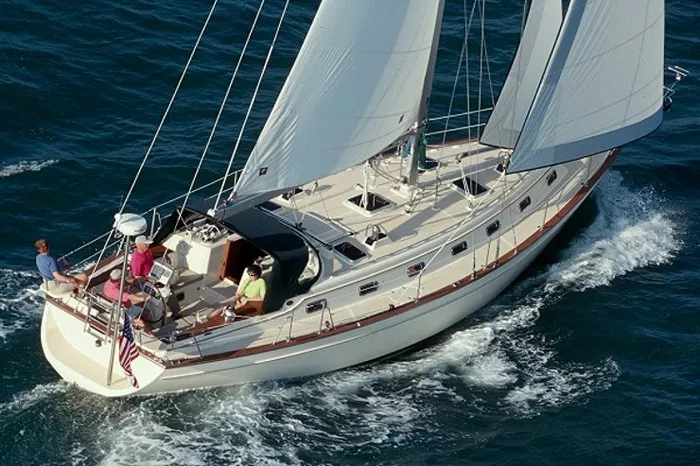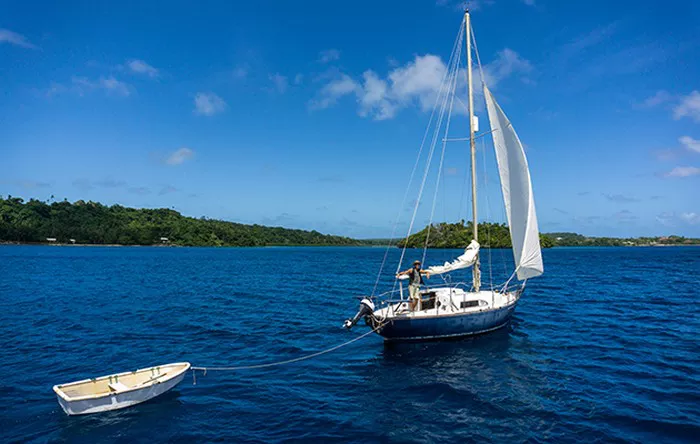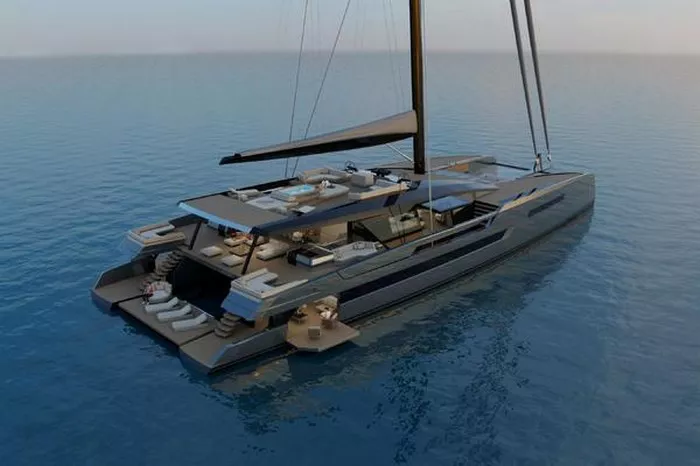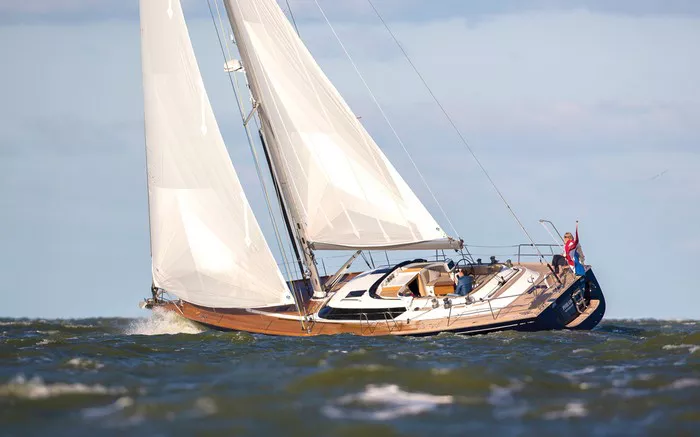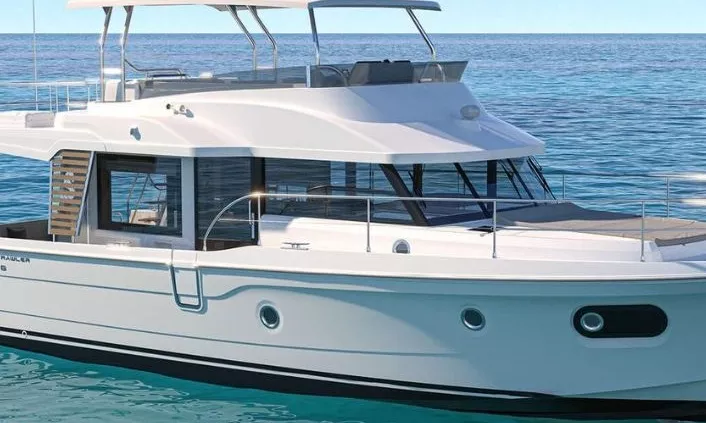Cruising Yacht Types
Cruising yachts come in a variety of types, each designed to serve different purposes and cater to various cruising conditions. Here’s a detailed breakdown of the main types of cruising yachts:
1. Monohull Cruising Yachts
Monohull yachts are the traditional style of yacht, featuring a single hull. They are typically designed for comfort, stability, and long-distance cruising.
Full-keeled Monohulls:
These yachts have a long, deep keel, which offers excellent stability and is great for long-distance cruising.
Pros: Strong, steady in heavy weather, and capable of making long ocean passages.
Cons: Slower in lighter winds and less maneuverable in tight spaces.
Fin-keeled Monohulls:
These have a shorter, deeper keel, offering better maneuverability and speed.
Pros: Good balance of performance and comfort. Faster than full-keels in lighter winds.
Cons: Less stability in heavy seas, and can sometimes feel less comfortable on longer trips.
Centerboard Monohulls:
These yachts feature a retractable centerboard, which allows for shallow draft when cruising in coastal areas or inlets.
Pros: Versatile and great for exploring shallower waters.
Cons: Can be a little less stable than a full-keel or fin-keel design in rough weather.
Fin and Skeg Monohulls:
This is a hybrid design that includes a fin keel for performance and a skeg to protect the rudder.
Pros: Offers good performance and rudder protection in turbulent seas.
Cons: Slightly more complex in construction and maintenance.
2. Catamarans
Catamarans feature two parallel hulls and are growing in popularity among cruising sailors. They offer more space and stability than monohulls, making them an excellent choice for families or those looking for luxurious cruising options.
Performance Catamarans:
These are designed for speed and often have more modern, sleek designs.
Pros: Very stable, excellent for larger groups, and spacious with dual hulls providing more deck and living area.
Cons: Typically more expensive, and larger versions can be harder to handle in tight spaces.
Cruising Catamarans:
These are built with comfort in mind, featuring large living areas, double or triple cabins, and plenty of room for storage.
Pros: More stable than monohulls, with lots of deck space and the ability to stand up in the cabin.
Cons: Slower in heavy winds, and larger models can be harder to handle in narrow or shallow waters.
3. Trimarans
Trimarans are less common but offer unique advantages. These yachts feature three hulls—one large central hull with two smaller outriggers.
Performance Trimarans:
Built for speed, these yachts are the go-to choice for competitive sailors but also offer exceptional cruising performance in the right conditions.
Pros: Stable, fast, and can handle rough seas.
Cons: Larger and more challenging to find in charter fleets. Can also be more difficult to maneuver in confined spaces.
Cruising Trimarans:
Designed for comfort, these yachts feature spacious cabins and generous deck areas.
Pros: Stability, speed, and more space than monohulls.
Cons: Can be more difficult to maintain, and the central hull often means higher costs.
4. Bluewater Yachts
These yachts are designed specifically for long, offshore passages and are built to withstand the harsh conditions of the open ocean.
Heavy-displacement Bluewater Yachts:
These yachts are built to endure the toughest of conditions. With strong hulls, thick fiberglass, and powerful engines, they’re designed for safe long-distance cruising.
Pros: Extremely sturdy, excellent in heavy weather, and comfortable for long voyages.
Cons: Heavy and slower, requiring more effort to handle in light winds.
Light-displacement Bluewater Yachts:
Lighter, faster, and more performance-oriented than heavy-displacement yachts, these yachts balance safety with speed.
Pros: Faster than heavier yachts, yet still designed for long ocean passages.
Cons: Less forgiving in extreme weather.
5. Luxury Yachts
Luxury yachts are high-end cruising vessels built with luxurious amenities and design. These yachts are typically very large, offering features like pools, helipads, and full-size kitchens.
Motor Yachts:
These yachts are powered by engines rather than sails and offer superior comfort, with large cabins, sun decks, and spacious dining areas.
Pros: Extremely comfortable, fast, and capable of cruising long distances without the need for sails.
Cons: Higher running costs, including fuel and maintenance.
Sailing Yachts:
These are large, sleek, and stylish yachts built for cruising with performance and luxury in mind.
Pros: Elegant design, ample space, and luxury features. Offers both sail and power cruising capabilities.
Cons: Expensive and require more crew to handle, especially for longer voyages.
6. Day Sailors
These are smaller yachts designed for short, local cruising rather than long passages.
Pocket Cruisers:
Typically under 30 feet in length, pocket cruisers are ideal for those looking for a manageable, easy-to-handle yacht for short coastal or inland cruising.
Pros: Affordable, easy to handle by one person or a small crew.
Cons: Limited living space and less suitable for long voyages.
7. Expedition Yachts
Expedition yachts are designed for long journeys to remote or extreme locations, often with self-sufficiency in mind.
Polar Expedition Yachts:
Built to endure extreme conditions, such as polar regions, these yachts are equipped with reinforced hulls and high-end safety features.
Pros: Rugged and capable of cruising in very challenging
environments.
Cons: Expensive, complex maintenance, and specialized equipment.
Trawler Yachts:
Designed for long, slow passages, trawler yachts are often used for coastal cruising or around the world trips at a leisurely pace.
Pros: Fuel-efficient, comfortable, and stable.
Cons: Slower cruising speed, and sometimes lack the performance of other yachts in rough weather.
8. Hybrid Yachts
These yachts combine the advantages of both motorized and sailing yachts, often equipped with sails for traditional cruising or engines for more efficient speed.
Motor-Sailers:
These yachts feature both sail and motor propulsion, often used for longer passages with minimal crew.
Pros: Versatile, capable of both sailing and motoring for longer distances.
Cons: Complicated systems and higher maintenance costs.
Each type of cruising yacht is suited for specific types of cruising, whether you are sailing the Mediterranean in comfort or navigating the high seas on a bluewater voyage. The choice will depend on your cruising goals, budget, and preferred sailing conditions.
Key Features of Cruising Yacht
Cruising yachts are designed for long voyages, often offering a blend of comfort, performance, and durability. They’re built for extended stays on the water, so their design emphasizes stability, ample living space, and versatility. Here are the key features of cruising yachts, detailed out:
1. Hull Design
Shape: Cruising yachts typically have a longer, fuller hull shape that offers more interior space and stability in various sea conditions.
Material: Most cruising yachts use fiberglass or composite materials for the hull, ensuring durability, low maintenance, and good weight distribution. Some high-end yachts may have aluminum hulls, offering additional strength.
Keel: The keel is usually heavier and deeper in cruising yachts, offering better stability and minimizing the risk of capsizing. Some yachts have a fin keel, full keel, or bilge keel, depending on the design and intended cruising area.
2. Rigging and Sail Plan
Sloop Rig: The most common rigging for cruising yachts, which includes a single mast, a main sail, and a foresail (jib or genoa). It’s relatively simple to handle, especially for solo or small crew sailing.
Cutter Rig: A rig with a second, smaller foresail (staysail) in addition to the jib. It’s suited for sailors who want more versatility in different wind conditions.
Ketch or Yawl Rig: These rigs have two masts. The smaller mast (mizzen) offers additional sail area, making them easier to handle in heavy winds.
Roller Furling: This system allows you to roll the foresail in and out without leaving the cockpit, improving safety and convenience when managing sails.
3. Cockpit
Size and Layout: Cruising yachts have spacious cockpits designed for comfort during long voyages. They often include ergonomically placed seating, allowing the crew to relax or work comfortably.
Shelter: Many yachts have a bimini or dodger (canvas covers) to protect against the sun and spray. Some also offer a full cockpit enclosure for inclement weather.
Helm Station: The steering wheel or tiller is often centrally located for easy navigation. Advanced yachts feature autopilots, GPS, and chartplotters integrated into the helm.
4. Deck and Rigging Systems
Deck Space: Cruising yachts have wide, uncluttered decks, providing ample space for movement and securing equipment. Non-slip surfaces are common to ensure safety in rough conditions.
Winches and Blocks: These are used for adjusting sails, lines, and rigging. Cruising yachts generally come with self-tailing winches, making sail handling easier.
Anchor and Windlass: A high-quality anchor system is critical for cruising yachts. Most feature a windlass (motorized winch) to handle large anchors, which is essential for anchoring in deeper waters.
5. Interior Layout and Comfort
Cabins: A cruising yacht typically has multiple cabins, often including a master stateroom and additional guest or crew cabins. The cabins are equipped with comfortable berths, storage, and sometimes en-suite bathrooms.
Salon and Galley: The main living area, known as the salon, is often spacious with large windows to offer a panoramic view of the sea. The galley is the onboard kitchen and is designed with full functionality, often featuring stoves, refrigerators, sinks, and counter space for meal preparation.
Heads (Bathrooms): Most cruising yachts have at least one full bathroom (head) with a shower, toilet, and sink. Larger yachts may have multiple heads for convenience.
Dining and Relaxation Areas: Some yachts feature dining areas that can convert into extra sleeping space. Lounges or settees provide comfort during extended stays on the water.
6. Storage and Tankage
Water Tanks: Cruising yachts usually have ample fresh water storage, often from 500 to 1,000 liters or more, to last for several days at sea without resupply.
Fuel Tanks: They are typically larger than those on racing yachts, allowing for longer cruising without the need for frequent fuel stops.
Storage for Gear: Cruising yachts offer large lockers for storing sails, safety gear, and provisions. There’s often a dedicated space for dive tanks, fishing gear, and other equipment needed for recreational activities.
7. Power Systems
Engines: Cruising yachts are equipped with reliable inboard engines, typically ranging from 40 to 150 horsepower, depending on the size of the yacht. This ensures that they can motor safely in case of calms or when entering ports.
Battery and Charging Systems: High-capacity battery banks are essential for cruising yachts, with solar panels and wind generators often added to charge batteries during extended stays away from shore.
Generator: Many cruising yachts come with an onboard generator to provide power for air conditioning, heating, and other electrical systems when at anchor.
8. Navigation and Safety Equipment
Navigation Instruments: GPS, radar, depth sounders, and chartplotters are standard for navigation. These systems help ensure accurate positioning and awareness of obstacles.
AIS (Automatic Identification System): AIS allows cruising yachts to identify and track other vessels, improving safety, especially when crossing busy shipping lanes.
Safety Gear: Cruising yachts are equipped with life vests, life rafts, fire extinguishers, flares, and emergency signaling equipment. Some yachts also have EPIRBs (Emergency Position-Indicating Radio Beacons) for distress situations.
9. Climate Control and Comfort
Air Conditioning/Heating: Many cruising yachts, especially larger ones, come with onboard air conditioning and heating to maintain comfort in various climates.
Ventilation: Good ventilation is key to preventing moisture buildup. Cruising yachts often have opening portholes, hatches, and ventilators to allow fresh air into the cabins.
Insulation: Insulated hulls and interiors can help regulate temperatures, making the yacht more comfortable in both hot and cold environments.
10. Performance Features
Ballast: To ensure stability, cruising yachts often use internal ballast (like lead or iron) to counterbalance the force of the wind on the sails. This keeps the yacht upright even in heavy weather.
Rudder and Steering: Cruising yachts generally use a spade rudder for precise handling, although some older models may have a full skeg rudder for additional protection.
Seaworthiness: Cruising yachts are built to handle various sea conditions, from calm seas to challenging open ocean swells. Their design ensures that they can safely handle rough waters while maintaining a comfortable ride.
11. Long-Distance Capabilities
Range: Cruising yachts are designed to travel long distances, with fuel, water, and food stores that allow for weeks or even months at sea.
Sustainability: Many modern cruising yachts feature green technologies, such as solar-powered systems, composting toilets, and hybrid propulsion systems, to reduce their environmental impact.
12. Luxury and Customization Options
Interior Finishes: For those seeking extra luxury, cruising yachts can be outfitted with high-end wood finishes, leather upholstery, and gourmet kitchens.
Custom Features: Many cruising yachts can be customized with extras like hot tubs, air conditioning, audio-visual systems, and more, depending on the owner’s preferences.
These features combine to make cruising yachts the perfect choice for those looking to spend extended time at sea, combining practical sailing performance with comfortable living amenities. Whether you’re exploring remote islands or enjoying coastal cruising, cruising yachts provide a versatile platform for adventure and relaxation.


